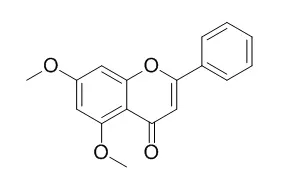| In vitro: |
| Antimicrob Agents Chemother. 2006 Apr;50(4):1352-64. | | Antitrypanosomal and antileishmanial activities of flavonoids and their analogues: in vitro, in vivo, structure-activity relationship, and quantitative structure-activity relationship studies.[Pubmed: 16569852] | Trypanosomiasis and leishmaniasis are important parasitic diseases affecting millions of people in Africa, Asia, and South America. In a previous study, we identified several flavonoid glycosides as antiprotozoal principles from a Turkish plant.
METHODS AND RESULTS:
Here we surveyed a large set of flavonoid aglycones and glycosides, as well as a panel of other related compounds of phenolic and phenylpropanoid nature, for their in vitro activities against Trypanosoma brucei rhodesiense, Trypanosoma cruzi, and Leishmania donovani. The cytotoxicities of more than 100 compounds for mammalian L6 cells were also assessed and compared to their antiparasitic activities. Several compounds were investigated in vivo for their antileishmanial and antitrypanosomal efficacies in mouse models.
METHODS AND RESULTS:
Overall, the best in vitro trypanocidal activity for T. brucei rhodesiense was exerted by 7,8-dihydroxyflavone (50% inhibitory concentration [IC50], 68 ng/ml), followed by 3-hydroxyflavone, rhamnetin, and 7,8,3',4'-tetrahydroxyflavone (IC50s, 0.5 microg/ml) and catechol (IC50, 0.8 microg/ml). The activity against T. cruzi was moderate, and only Chrysin dimethylether and 3-hydroxydaidzein had IC50s less than 5.0 microg/ml. |
|






 Cell. 2018 Jan 11;172(1-2):249-261.e12. doi: 10.1016/j.cell.2017.12.019.IF=36.216(2019)
Cell. 2018 Jan 11;172(1-2):249-261.e12. doi: 10.1016/j.cell.2017.12.019.IF=36.216(2019) Cell Metab. 2020 Mar 3;31(3):534-548.e5. doi: 10.1016/j.cmet.2020.01.002.IF=22.415(2019)
Cell Metab. 2020 Mar 3;31(3):534-548.e5. doi: 10.1016/j.cmet.2020.01.002.IF=22.415(2019) Mol Cell. 2017 Nov 16;68(4):673-685.e6. doi: 10.1016/j.molcel.2017.10.022.IF=14.548(2019)
Mol Cell. 2017 Nov 16;68(4):673-685.e6. doi: 10.1016/j.molcel.2017.10.022.IF=14.548(2019)